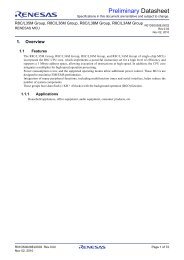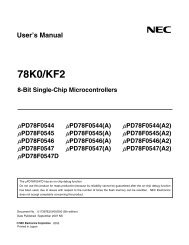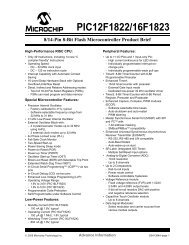1.8V Low Power Open-Drain Output Comparator - Microchip
1.8V Low Power Open-Drain Output Comparator - Microchip
1.8V Low Power Open-Drain Output Comparator - Microchip
Create successful ePaper yourself
Turn your PDF publications into a flip-book with our unique Google optimized e-Paper software.
MCP6566/6R/6U/7/9<br />
4.6 PCB Surface Leakage<br />
In applications where low input bias current is critical,<br />
PCB (Printed Circuit Board) surface leakage effects<br />
need to be considered. Surface leakage is caused by<br />
humidity, dust or other contamination on the board.<br />
Under low humidity conditions, a typical resistance<br />
between nearby traces is 10 12 Ω. A 5V difference would<br />
cause 5 pA of current to flow. This is greater than the<br />
MCP6566/6R/6U/7/9 family’s bias current at +25°C<br />
(1 pA, typical).<br />
The easiest way to reduce surface leakage is to use a<br />
guard ring around sensitive pins (or traces). The guard<br />
ring is biased at the same voltage as the sensitive pin.<br />
An example of this type of layout is shown in<br />
Figure 4-9.<br />
IN-<br />
IN+<br />
V SS<br />
4.7 PCB Layout Technique<br />
When designing the PCB layout it is critical to note that<br />
analog and digital signal traces are adequately<br />
separated to prevent signal coupling. If the comparator<br />
output trace is at close proximity to the input traces<br />
then large output voltage changes from, V SS to V DD or<br />
visa versa, may couple to the inputs and cause the<br />
device output to oscillate. To prevent such oscillation,<br />
the output traces must be routed away from the input<br />
pins. The SC70-5 and SOT-23-5 are relatively immune<br />
because the output pin OUT (pin 1) is separated by the<br />
power pin V DD /V SS (pin 2) from the input pin +IN (as<br />
long as the analog and digital traces remain separated<br />
through out the PCB). However, the pinouts for the dual<br />
and quad packages (SOIC, MSOP, TSSOP) have OUT<br />
and -IN pins (pin 1 and 2) close to each other. The<br />
recommended layout for these packages is shown in<br />
Figure 4-10.<br />
OUTA<br />
-INA<br />
+INA<br />
V DD<br />
OUTB<br />
-INB<br />
Guard Ring<br />
FIGURE 4-9: Example Guard Ring Layout<br />
for Inverting Circuit.<br />
1. Inverting Configuration (Figures 4-6 and 4-9):<br />
a) Connect the guard ring to the non-inverting<br />
input pin (V IN +). This biases the guard ring<br />
to the same reference voltage as the<br />
comparator (e.g., V DD /2 or ground).<br />
b) Connect the inverting pin (V IN –) to the input<br />
pad without touching the guard ring.<br />
2. Non-inverting Configuration (Figure 4-4):<br />
a) Connect the non-inverting pin (V IN +) to the<br />
input pad without touching the guard ring.<br />
b) Connect the guard ring to the inverting input<br />
pin (V IN –).<br />
V SS<br />
FIGURE 4-10:<br />
Recommended Layout.<br />
4.8 Unused <strong>Comparator</strong>s<br />
+INB<br />
An unused amplifier in a quad package (MCP6569)<br />
should be configured as shown in Figure 4-11. This<br />
circuit prevents the output from toggling and causing<br />
crosstalk. It uses the minimum number of components<br />
and draws minimal current (see Figure 2-15 and<br />
Figure 2-15).<br />
¼ MCP6569<br />
V DD<br />
–<br />
+<br />
FIGURE 4-11:<br />
Unused <strong>Comparator</strong>s.<br />
DS22143B-page 20<br />
© 2009 <strong>Microchip</strong> Technology Inc.
















